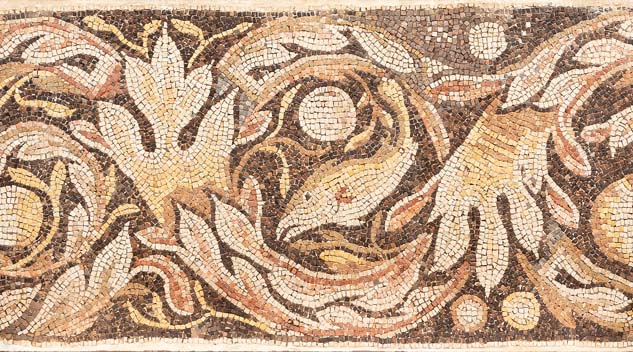#Doyle #Displays #Strength #European #Antiques #Antiques #Arts #Weekly
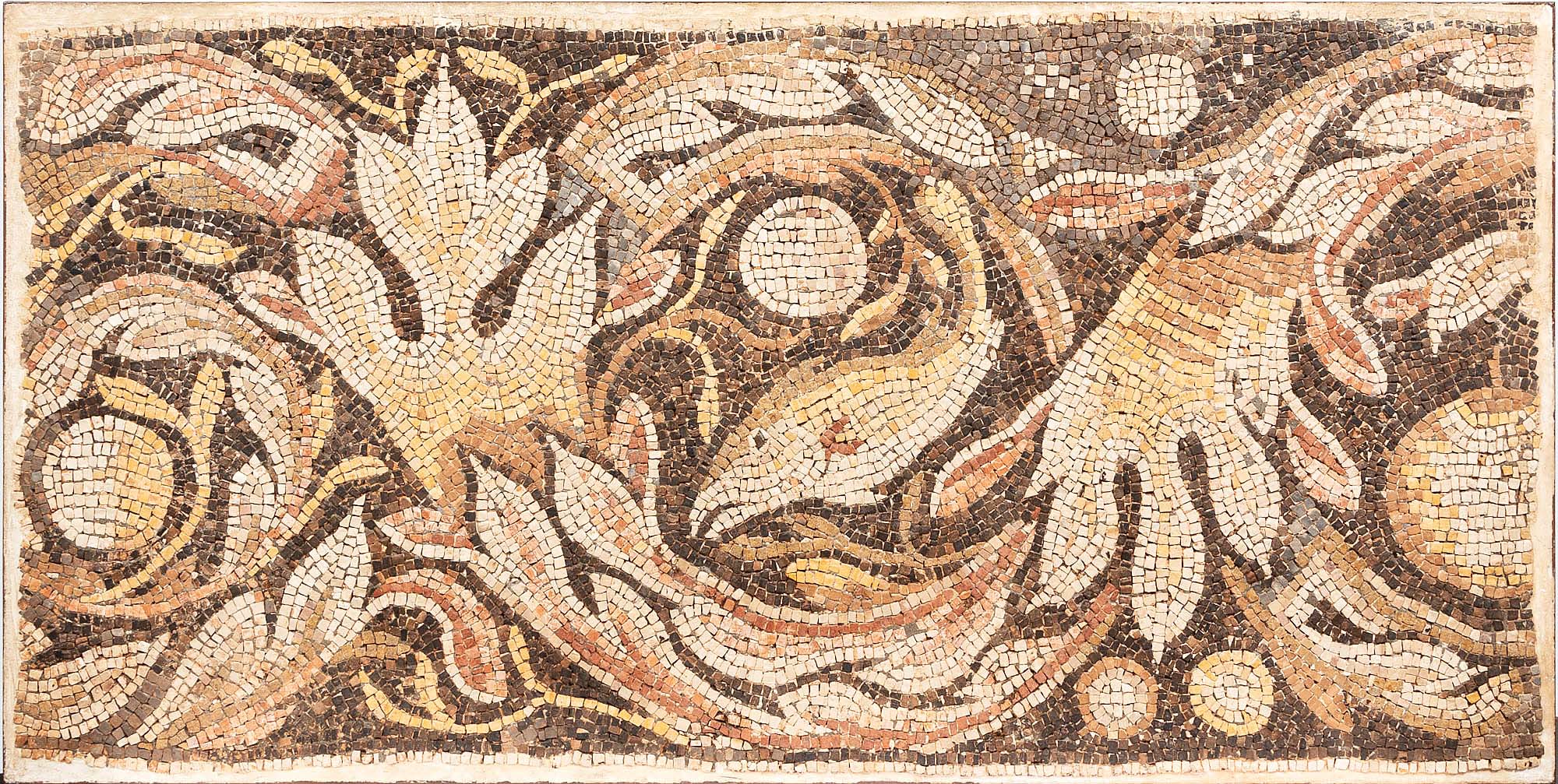
The top lot in the January 25 sale, a rectangular Roman mosaic panel of a garland and fish dating from the Second-Third Century CE achieved $44,800, more than doubling its $15/20,000 estimate.
Review by Carly Timpson; Photos Courtesy Doyle
NEW YORK CITY — To close out January, Doyle Auctions presented two days of European antiques auctions. On Wednesday, January 24, the auction focused primarily on Russian objects of vertu and English and Continental silver, while the next day’s sales included arts and furniture. Between the two, Doyle offered more than 600 lots of antiques from sophisticated estates and collections.
Fabergé & Vertu & English & Continental Silver
The January 24 auction offered 225 lots ranging from the Seventeenth Century to the Twentieth Century, including Fabergé, vertu, silver and icons from prominent collections and estates. The sale closed with 83 percent of lots successfully transferring hands and a majority of lots exceeding their estimates. Mark Moehrke, Doyle’s senior vice president and director of Russian works of art, shared that “the market for Fabergé and vertu has been popular…In addition to a substantial number of US bidders, there was a large international reach including bidders from Europe, the Middle East and other countries.”
The day’s top lot was a Russian bronze sculpture, “Mephistopheles.” Completed by Mark Antokolsky in 1883, the seated male figure sold to an international collector for $70,350. Antokolsky’s “Mephistopheles” is a depiction of a demon from German folklore, also called Mephisto. Moehrke noted that the performance of this bronze was aided in part by the fact that it had belonged to a private collection and had been off the market for more than 30 years.

Commanding the top spot in the sale was Mark Antokolsky’s (Russian, 1843-1902) 1883 bronze statue “Mephistopheles.” Signed “Antocolsky” with an F. Barbedienne Foundry mark on the base and measuring 33½ inches tall, the figure earned $70,400 ($30/50,000).
The second-highest finish, and the top lot in the silver category, was a pair of William IV wine coolers by London silversmith Benjamin Smith. With fluted campana form and flared rocaille rims, the bodies of the wine coolers had molded grapevine decorations and were engraved with the arms of Ald. Todd Sell, the silver specialist for Doyle, commented that the set “came from a private family who has had them for over 50 years, so they were fresh to the market. They were great quality and really good examples of the work of London’s great silversmiths of the period.”
A small rectangular Fabergé silver and enamel hinged box earned $23,040 despite illegible inventory markings. The outside of the box was intricately decorated with flowers, scrolls and geometric motifs with multicolor cloisonné enamel. From the estate of David Killen, this Moscow-made presentation box had a Russian inscription on the inside cover, dating to 1912-13.
Finishing at the same price was a brass samovar. According to Moehrke, the original collector lived and worked in Russia before moving to California, and this samovar, along with a wealth of other items, was in their collection for a century. The late Eighteenth Century brass vessel was of urn form and embossed throughout. Prominently displayed on the front above the spout was a Russian Imperial double-headed eagle and on the reverse was a Green Man. The $23,040 realized for this samovar far exceeded its $800-$1,200 estimate.
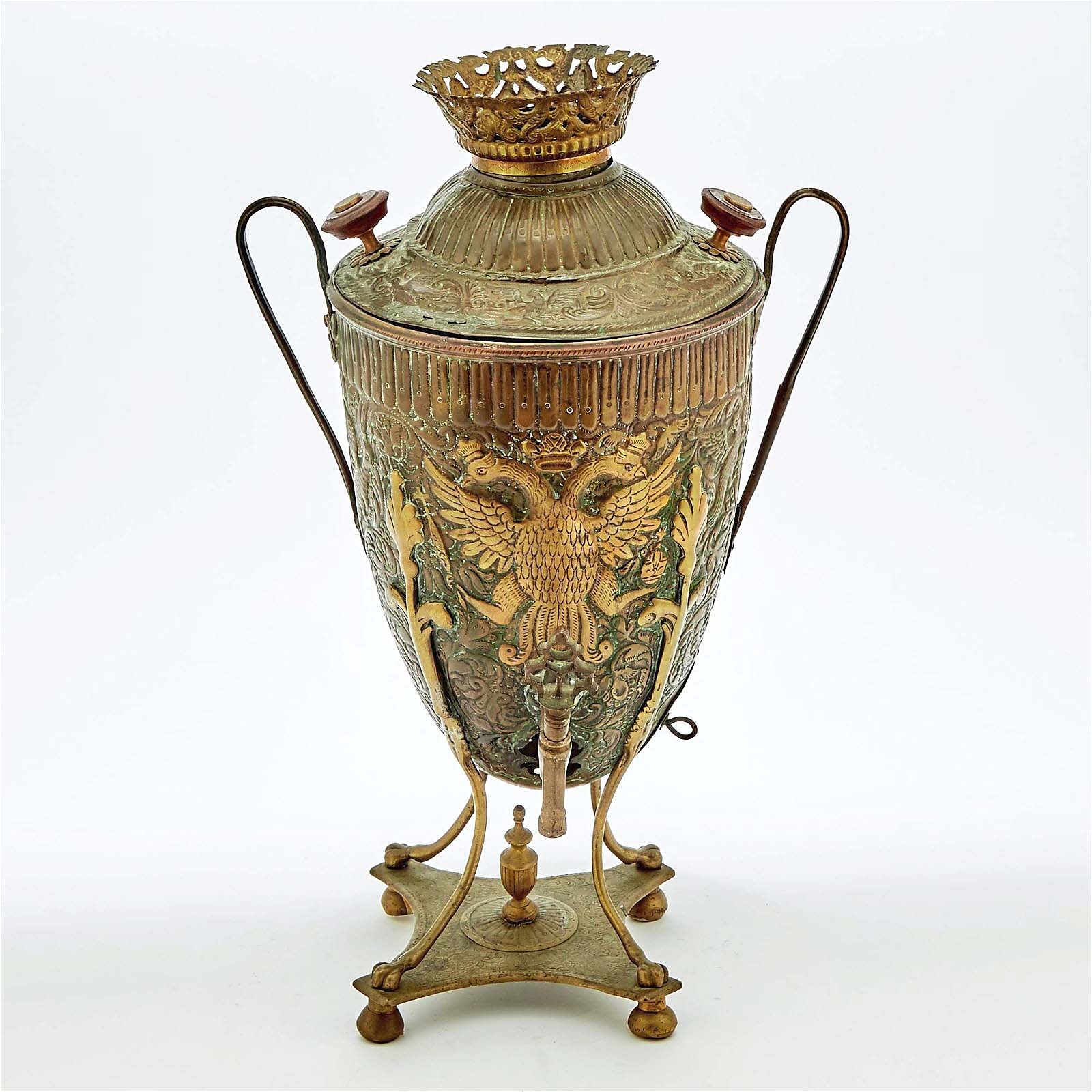
This late Eighteenth Century Russian brass samovar on four scroll legs, 19½ inches tall, elicited $23,040 ($800-$1,200).
Crossing the block at $21,760 was an assembled set of George III sterling silver candlesticks. While all six candlesticks appear to be aesthetic matches, four were marked Simon Le Sage, one was marked Augustin Le Sage and the final was unmarked. “They are an impressive size and, again, the quality is top-notch; the Corinthian capitals are pierced so that there is real depth to the decoration! The makers, Augustin and Simon Le Sage were part of a Huguenot family of silversmiths that helped to bring the latest styles in silverware to English homes,” shared Sell.
The next silver lot to find success was a Twentieth Century sterling silver flatware service for 14 in the Albi pattern from Christofle, which achieved $14,080. Sell commented on the success of this service, which doubled its mid-range estimate, saying that the flatware “came from yet another private home and sold to a private buyer. Christofle is known for its silver, but its sterling silver is a little scarcer and people are always looking for the best! The clean lines on this pattern make it timeless and easy to adapt to any tablescape.”
An unmarked carved hardstone charka earned $20,480 against an estimated $10/12,000 and will be heading to a Western Europe collection. In the Nineteenth and Twentieth Centuries, Russian makers excelled in crafting gold-mounted hardstone carvings. This agate drinking bowl was decorated with applied gold vines and flowers, set with rubies, and had a gold and enamel floral band around the rim. The charka’s handle, engraved with the crowned cipher of Empress Catherine II and the date 1789, was set with rubies and emeralds.
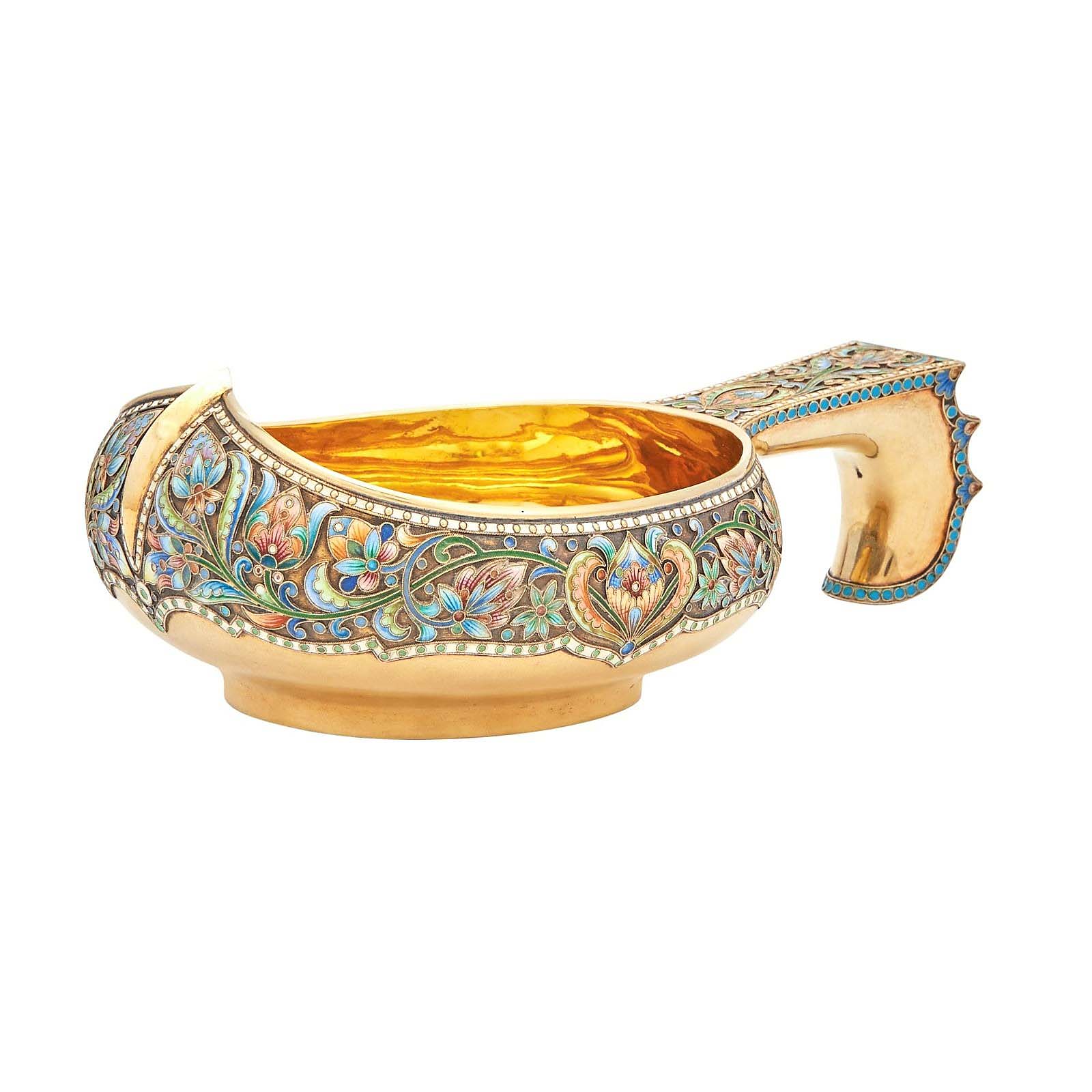
This Russian silver-gilt and cloisonné enamel kovsh, Ovchinnikov, Moscow, 1908-17, 8½ inches, earned $17,920 ($7/9,000).
Another traditional Russian drinking vessel, a kovsh, finished behind the charka. Of typical form, this silver-gilt Kovsh bore the mark from Moscow maker Pavel Ovchinnikov. Ovchinnikov was one of the best silversmiths and, as such, this kovsh was of very high-quality silver and cloisonné enamel. The bowl and handle both feature enameled bands of colorful flowers and foliage between dotted borders. Originating from a private West Coast collection, the Kovsh went out for $17,920.
Old Master & Nineteenth Century Paintings, Drawings & Prints and English & Continental Furniture & Decorative Arts
The January 25 art and furniture sale consisted of property from the Manolovici Collection and the Collection of New York City Hostess Alice Mason among other prominent estates and collections. The 382-lot sale generated a sell-through rate of 82 percent.
The leading lot of the day was a circa Second or Third Century Roman mosaic panel depicting a centrally located fish swimming among scrolling plants. The original mosaic was refinished with a modern cement matrix and metal frame to ensure its continued longevity. Ultimately, the panel stretched to $44,800. A similar mosaic earned $25,600. However, this one was a large square with a circular geometric pattern and may have been made between the Second and Fourth Centuries. The tiles of this composition are laid out with a central geometric square, surrounded by circular rings, an undulating band and a triangle in each corner.
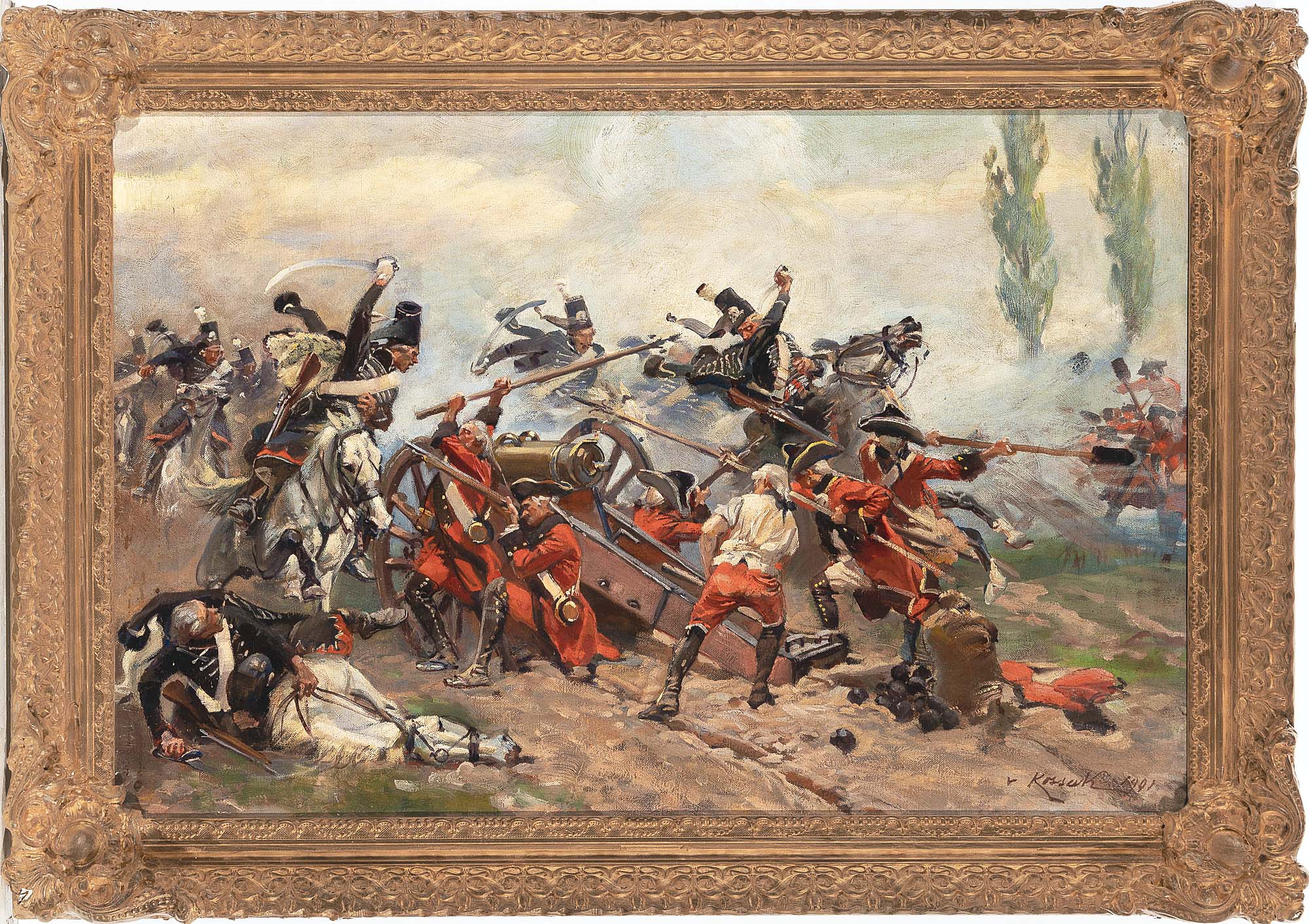
“The Charge of the Black Hussars” by Wojciech Horacy Kossak (Polish, 1856-1942), 1901, oil on canvas, 29-5/8 by 19¾ inches, earned $28,800 ($8/12,000).
Finishing as the second-highest position for the day and the top of the Old Master and Nineteenth Century art category was an oil painting by Wojciech Horacy Kossak. The 1901 painting, “The Charge of the Black Hussars,” depicts an encounter between Prussia’s Black Hussars and Russian artillery during the Seven Year’s War. Affixed to the reverse of the painting is a gilt wooden label with German writing that translates to “With the highest approval of His Majesty the Emperor on May 20, 1901.” Estimated at only $8/12,000, the military scene in a period frame crossed the block for $28,800.
Exceeding all expectations, an unsigned chalk portrait titled “Young Woman Holding a Birdcage” earned $25,600 ($500/700). Cataloged as after Francois Boucher, the illustration “is a second version of a drawing by Boucher in the collection of the Morgan Library in New York. That work was a study for ‘The Bird Catchers,’ a tapestry cartoon now in the Getty Museum in Malibu, Calif.”
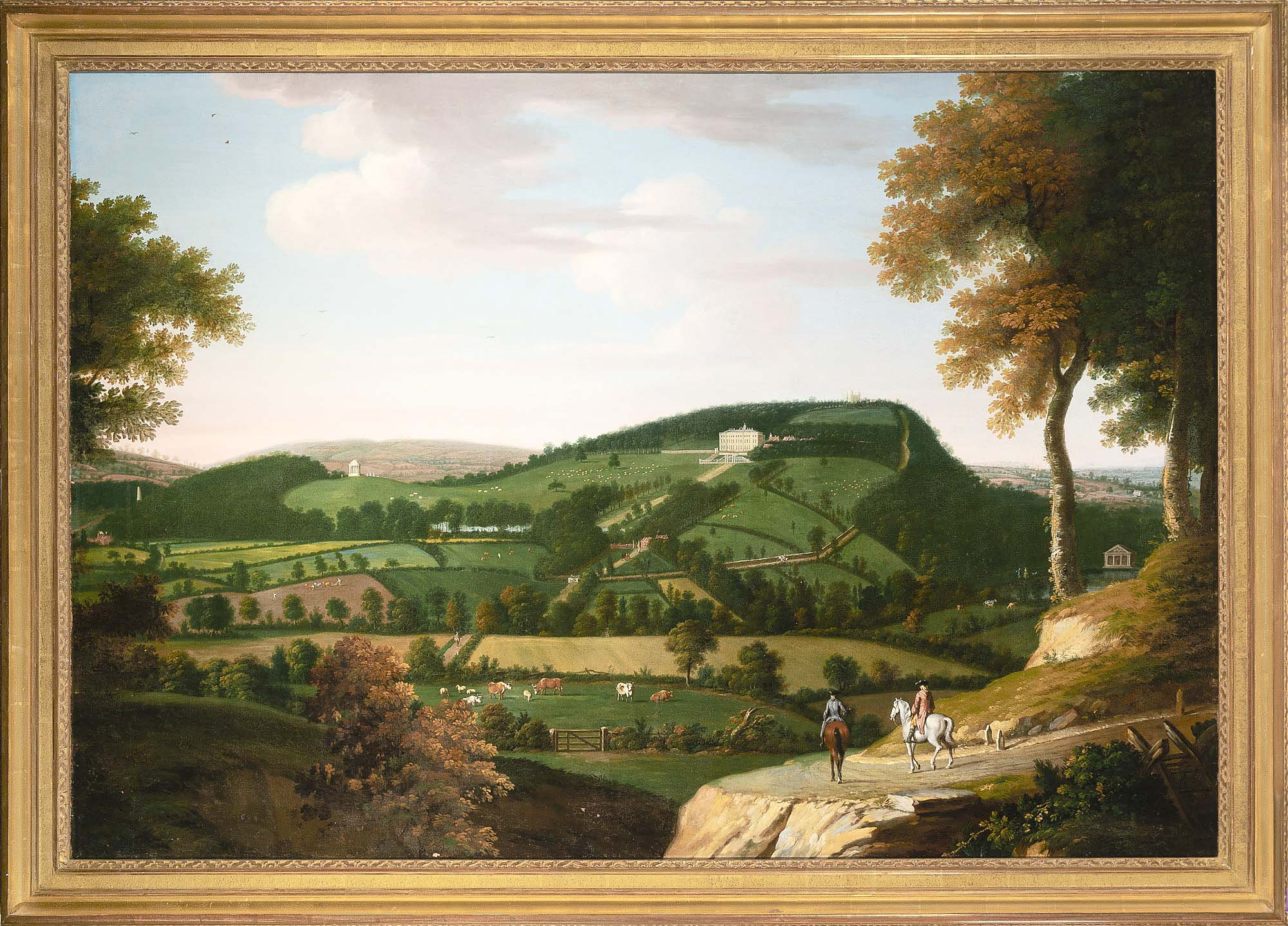
“A View of Haldon House, Devon” by Thomas Bardwell (British, 1704-1776), oil on canvas, 58 by 40 inches, sold for $23,040 ($5/7,000).
Finishing at $23,040 were three pieces highlighting the diversity in this sale. One was an oil painting, “A View of Haldon House, Devon,” by British artist Thomas Bardwell. The work depicts lush green hills, with two men on horseback in the foreground, overlooking the countryside with a stately house on a hill in the background. Another was a circa 1780 Louis XVI ormolu-mounted and painted marble mantel clock. Its floral-painted dial was signed “De Belle” and featured a central aperture showing the phases of the moon.
The last lot to achieve this price was a George III mahogany four-poster bed. The bed had a pierced serpentine cornice with scrolling foliage and cluster-column baluster foot posts on square legs. All three of these lots were from private New York collections.
Prices quoted include the buyer’s premium as reported by the auction house. Doyle will be conducting an auction of Fine Jewelry & Luxury Handbags on February 29. For information, www.doyle.com or 212-427-2730.

